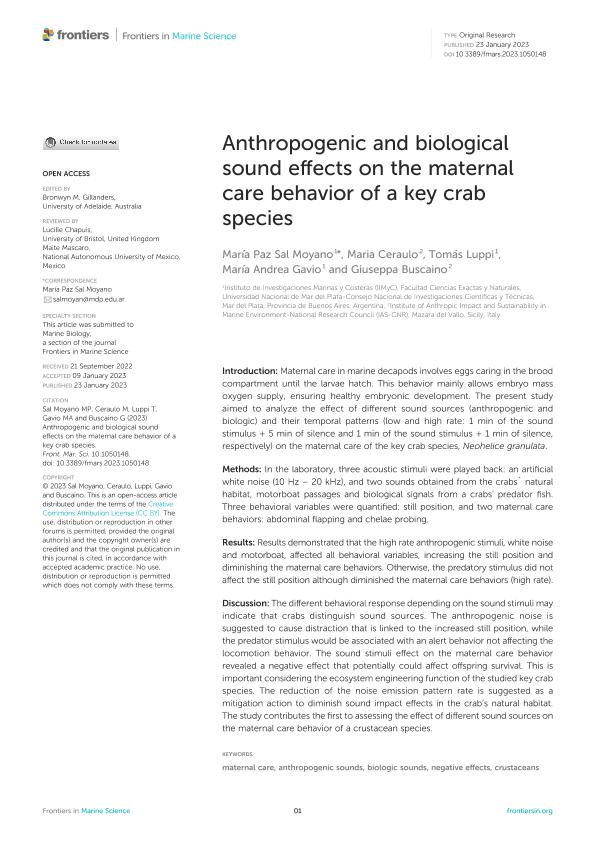Artículo
Anthropogenic and biological sound effects on the maternal care behavior of a key crab species
Sal Moyano, María Paz ; Ceraulo, Maria; Luppi, Tomas Atilio
; Ceraulo, Maria; Luppi, Tomas Atilio ; Gavio, Maria Andrea; Buscaino, Giuseppa
; Gavio, Maria Andrea; Buscaino, Giuseppa
 ; Ceraulo, Maria; Luppi, Tomas Atilio
; Ceraulo, Maria; Luppi, Tomas Atilio ; Gavio, Maria Andrea; Buscaino, Giuseppa
; Gavio, Maria Andrea; Buscaino, Giuseppa
Fecha de publicación:
01/2023
Editorial:
Frontiers Media
Revista:
Frontiers In Marine Science
ISSN:
2296-7745
Idioma:
Inglés
Tipo de recurso:
Artículo publicado
Clasificación temática:
Resumen
Introduction: Maternal care in marine decapods involves eggs caring in the brood compartment until the larvae hatch. This behavior mainly allows embryo mass oxygen supply, ensuring healthy embryonic development. The present study aimed to analyze the effect of different sound sources (anthropogenic and biologic) and their temporal patterns (low and high rate: 1 min of the sound stimulus + 5 min of silence and 1 min of the sound stimulus + 1 min of silence, respectively) on the maternal care of the key crab species, Neohelice granulata. Methods: In the laboratory, three acoustic stimuli were played back: an artificial white noise (10 Hz – 20 kHz), and two sounds obtained from the crabs´ natural habitat, motorboat passages and biological signals from a crabs’ predator fish. Three behavioral variables were quantified: still position, and two maternal care behaviors: abdominal flapping and chelae probing. Results: Results demonstrated that the high rate anthropogenic stimuli, white noise and motorboat, affected all behavioral variables, increasing the still position and diminishing the maternal care behaviors. Otherwise, the predatory stimulus did not affect the still position although diminished the maternal care behaviors (high rate). Discussion: The different behavioral response depending on the sound stimuli may indicate that crabs distinguish sound sources. The anthropogenic noise is suggested to cause distraction that is linked to the increased still position, while the predator stimulus would be associated with an alert behavior not affecting the locomotion behavior. The sound stimuli effect on the maternal care behavior revealed a negative effect that potentially could affect offspring survival. This is important considering the ecosystem engineering function of the studied key crab species. The reduction of the noise emission pattern rate is suggested as a mitigation action to diminish sound impact effects in the crab’s natural habitat. The study contributes the first to assessing the effect of different sound sources on the maternal care behavior of a crustacean species.
Archivos asociados
Licencia
Identificadores
Colecciones
Articulos(IIMYC)
Articulos de INSTITUTO DE INVESTIGACIONES MARINAS Y COSTERAS
Articulos de INSTITUTO DE INVESTIGACIONES MARINAS Y COSTERAS
Citación
Sal Moyano, María Paz; Ceraulo, Maria; Luppi, Tomas Atilio; Gavio, Maria Andrea; Buscaino, Giuseppa; Anthropogenic and biological sound effects on the maternal care behavior of a key crab species; Frontiers Media; Frontiers In Marine Science; 10; 1-2023; 1-11
Compartir
Altmétricas



